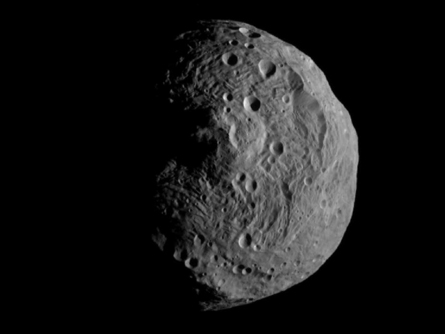The first close-up image of a main-belt asteroid reveals a rocky world that sports a cratered surface, parallel grooves and jagged ridges. The photograph of Vesta was taken by NASA’s Dawn spacecraft, which slipped into orbit around the second largest main-belt asteroid early in the morning of July 16 EDT.

Among other tasks, Dawn will spend a year helping astronomers precisely measure the asteroid’s mass and gravity, look for minimoons and make detailed maps from less than 200 kilometers above the pockmarked chunk of rock. Scientists think Vesta has one of the oldest remaining primordial surfaces in the solar system, and hope that its 4.5 billion-year-old face will provide information about the newborn solar system.
“How did planet formation take place? What are the big events?” asks planetary scientist William Bottke of the Southwest Research Institute in Boulder, Colo. Bottke likens asteroids to evidence at a crime scene: they help reconstruct events and contain information that a body – or planet – doesn’t. “They’re like blood splatter or bone fragments and such,” Bottke says. “These little guys provide amazing constraints on the big processes that have taken place. They’re stuff left over the crime, and we use them to piece together what’s happened.”
Managed by NASA’s Jet Propulsion Laboratory in Pasadena, Calif., Dawn traveled 2.8 billion kilometers before being captured by Vesta, powered by ion engines that propel the spacecraft forward at higher velocities than any other technology available today.







